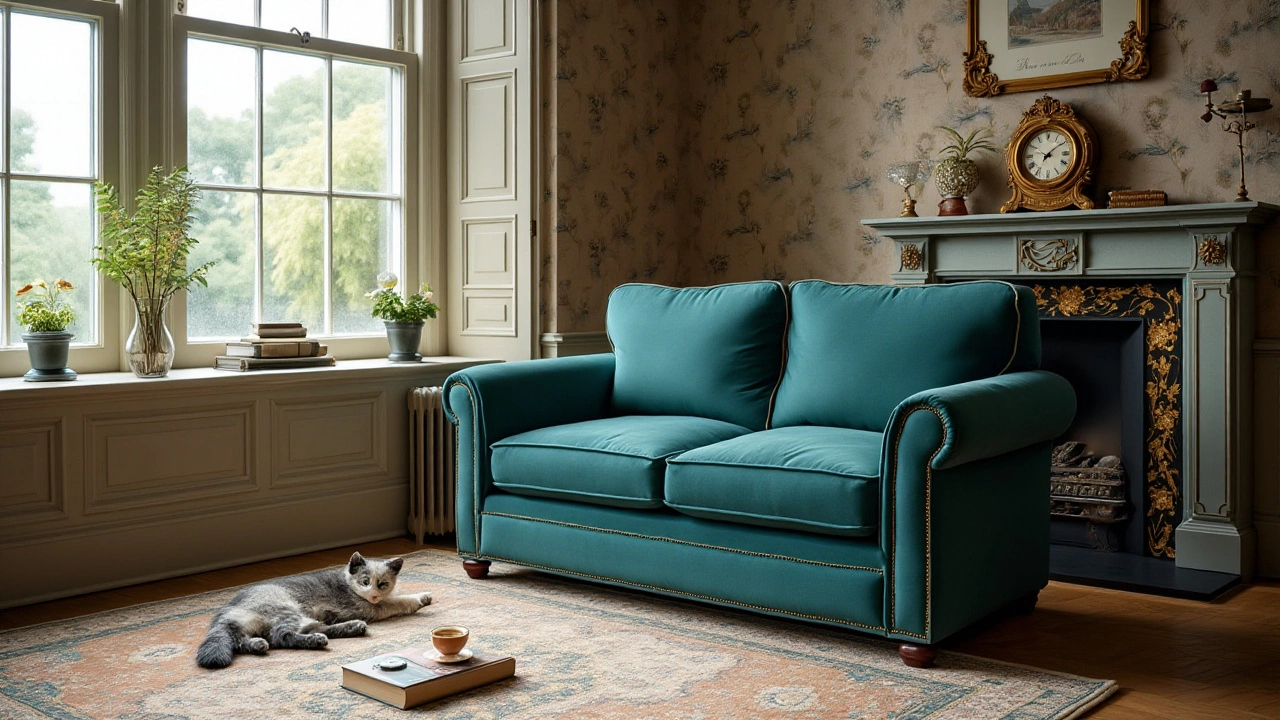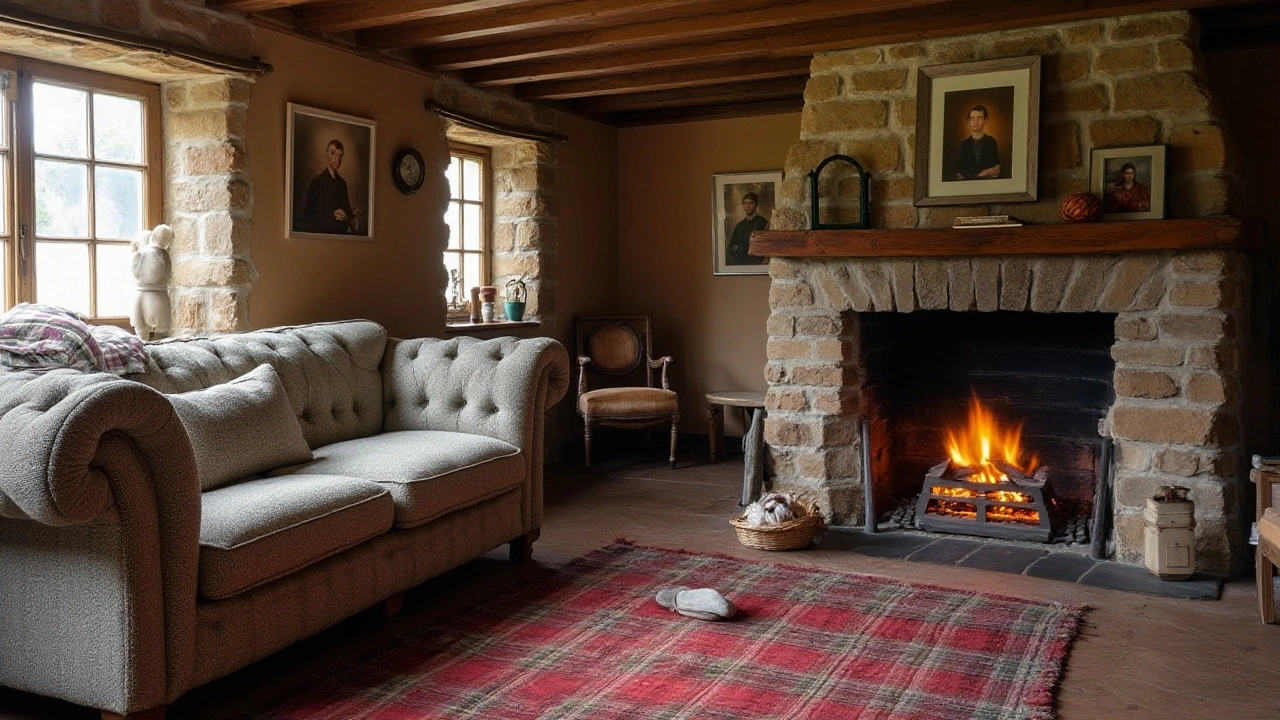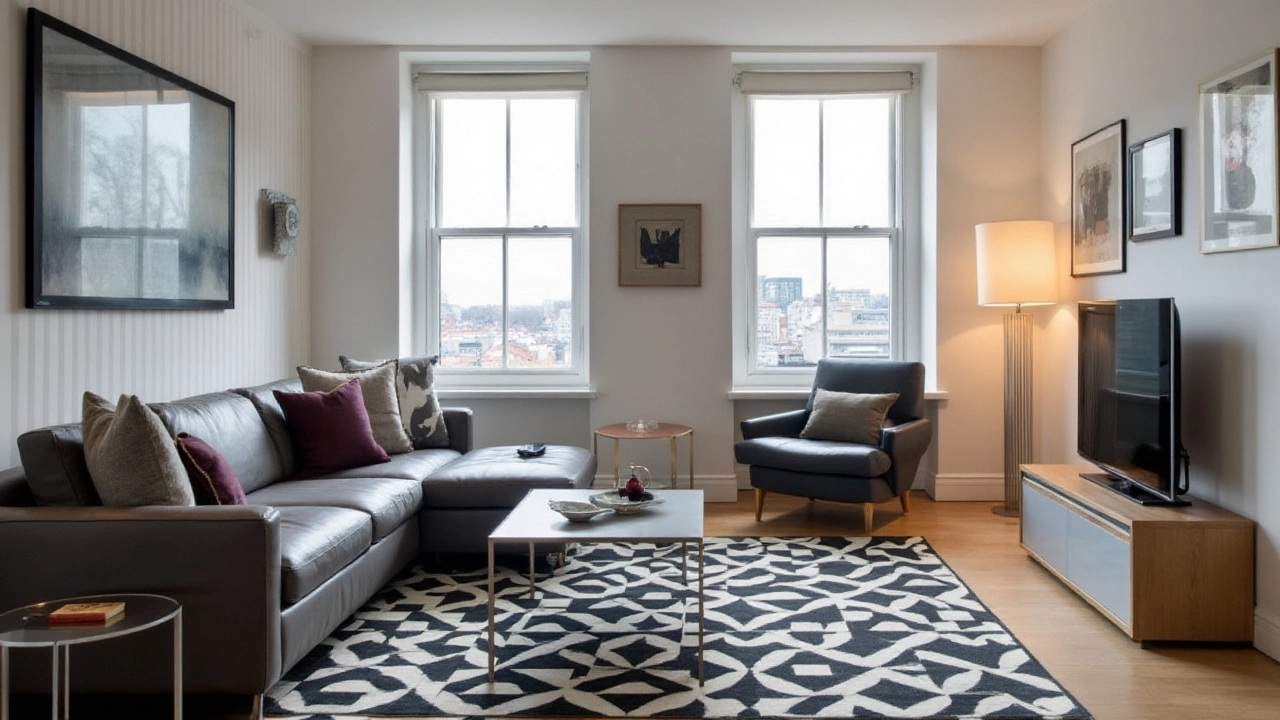Should You Place a Rug Under Your Sofa? A Complete Guide
 Jan, 21 2025
Jan, 21 2025
Walking into a living room, our eyes are often drawn to how a space comes together, and a rug can play a pivotal role in that experience. It isn't just about adding color or texture, but also about anchoring the furniture and influencing the room's atmosphere.
Before diving into style and aesthetics, let's consider why we might position a rug under a sofa at all. It impacts walking comfort, noise insulation, and even the coziness factor. But is it right for every home? That depends on various personal tastes and practical considerations.
- The Psychology of Rugs
- Practical Benefits of a Rug Under the Sofa
- Choosing the Right Size and Material
- Design Tips for Various Room Styles
- Maintenance and Care Tips
The Psychology of Rugs
Rugs are more than mere decorative elements; they possess an intriguing ability to influence mood and perception within a living room. The choice of a rug under the sofa can significantly alter how a space is perceived both aesthetically and emotionally. Color psychologists suggest that the hues of a rug can evoke specific emotions, with warmer tones like reds and oranges offering a sense of coziness and energy, while cooler shades like blues and greens may promote relaxation and tranquility. As such, selecting the right color is critical not only for style but also for creating the desired atmosphere within your home.
The texture of a rug is another subtle yet powerful psychological cue. Plush, soft textures tend to invite comfort and warmth, encouraging inhabitants and guests alike to linger and relax. This is particularly relevant in a living room setting where relaxation and togetherness often take center stage. Rougher or more complex textures can provide a different tactile experience, often associated with a rustic or minimalist aesthetic. Incorporating various textures through interior design can add depth and interest to a space, potentially leading to a more dynamic emotional environment.
Another compelling aspect is the pattern of the rug, which can also carry psychological weight. A striking pattern might energize a space, creating visual interest and movement. This is especially beneficial in rooms that might otherwise appear too static. On the flip side, simpler, understated patterns can maintain a serene and uncluttered ambiance. In fact, studies have shown that spaces with excessive visual noise might contribute to increased stress or distraction, highlighting the importance of thoughtful pattern selection when considering your living room decor.
"The floor, belonging as it does to the private surface of the house, provides the interactional bedrock of everyday life," says renowned designer Terence Conran. His words encapsulate the notion that rugs do more than just cover floors—they can fundamentally transform everyday experiences within the home setting. By grounding furniture arrangements and uniting disparate elements of an interior, rugs have the power to create harmony and balance, solidifying Conran's assertion.
Rugs serve as visual anchors by delineating and defining spaces within larger rooms. This is particularly useful in open-plan designs where distinguishing between different functional zones can be challenging. By placing a rug under your sofa, you effectively carve out a domain dedicated to conversation and comfort, a subtle psychological reminder of the tranquility expected in that space. As societal norms shift towards open and adaptable living spaces, the role of rugs as functional and psychological anchors continues to grow more pronounced.
Lastly, the interaction between lighting and rugs is a noteworthy factor. Different textures and colors interact uniquely with light, creating varied visual effects and affecting ambiance. A richly colored living room decor rug near a window might change tones as daylight shifts throughout the day, offering a dynamic and multilayered spatial experience. This dance of light and material can subtly guide emotional responses, whether invigorating morning enthusiasm or restful evening calm. Undoubtedly, understanding the psychology behind rug choices can enhance your ability to create a living space that resonates with personal preferences and family needs.
Practical Benefits of a Rug Under the Sofa
Having a rug under your sofa is more than just a stylish choice—it's a functional one. First, consider the comfort factor. Rugs offer a soft barrier between your feet and a hard floor surface, making lounging in your living room a much cozier experience. The additional layer provided by a rug also results in a warmer space, literally. Carpets and rugs possess intrinsic insulating properties that help retain heat, which can be especially beneficial during chilly seasons, resulting in noticeable energy savings.
From a noise reduction standpoint, a rug can make quite a difference in a bustling home. The thick fibers of rugs act as a buffer to absorb sound, diminishing echoes and noise levels. This can prove invaluable in apartments or homes where noise travels easily between levels and rooms. By reducing noise pollution, you cultivate a tranquil and more inviting environment suitable for both work and relaxation.
Adding a rug under the sofa isn't just an aesthetic upgrade—it's also about protecting your flooring from wear and tear. Be it hardwood, tile, or laminate, any floor will show signs of age over time, particularly in high traffic areas like the space around the sofa. Rugs absorb the brunt of foot traffic, shielding your floors from dirt and potential scratches.
"The right rug selection not only protects floors but also ties together the diverse elements in a room," remarks interior designer Greta Ward.
There’s an often-underestimated psychological benefit to placing a rug under your living room furniture, specifically the sofa. The tactile texture and vibrant or calming patterns can create a sense of grounding and harmony. It subtly delineates the space, giving the room definition and encouraging more natural foot traffic flow, thus enhancing your home's intuitive design.
Apart from comfort and practicality, rugs contribute significantly to the safety of your home. The sofa, depending on its weight and size, can slide on some types of flooring. A rug creates friction that helps to anchor your sofa in place, preventing unexpected shifts and potential accidents. Moreover, rugs reduce the risk of someone slipping, providing a textured surface that grips feet more effectively than a bare floor would.
For those who appreciate flexibility in decor, rugs offer the ease of transforming a space without a full remodel. Swap out a rug beneath your sofa for one with a seasonal pattern or a pop of color, and you’ve achieved a fresh new look with minimal effort. Simple changes like these make it easier to adapt to growing trends or shifts in personal taste, ensuring your space always feels current and reflective of who you are.

Choosing the Right Size and Material
When it comes to selecting the perfect rug for under your sofa, size and material are two critical considerations that can make or break the look of your living room. A common guideline for sizing is to ensure that either all the furniture sits on the rug or at least the front legs of the main pieces, such as the sofa, are on it. This helps to visually connect the elements in the room, creating a harmonious flow that appeals to the eye. If you choose a rug that is too small, the space might seem disjointed, whereas a rug that is too large can overwhelming the room, leaving no space for other design elements to shine.
Materials for rugs vary widely, each offering unique benefits. Wool rugs, for example, are noted for their durability and comfort. A wool rug can withstand heavy foot traffic and maintains its appearance over time, making it a popular choice for living room interior design. On the other hand, synthetic materials like polypropylene and nylon offer economic alternatives and are often stain-resistant, an essential quality if you have kids or pets. Natural fibers like jute or sisal add texture and a rustic vibe but might lack the softness one expects from a living room rug.
Understanding Rug Materials
Understanding the pros and cons of different rug materials can help you make an informed decision. Wool, for instance, is not only durable but highly insulating, which can add warmth to your room. It's a renewable resource and can naturally resist dirt and staining due to its fibers' outer layer. However, it's worth noting that some high-quality wool rugs can be pricey. In contrast, synthetic rugs can mimic the appearance of natural fibers at a fraction of the cost. They also tend to require less maintenance, which could save you time and effort in the long run.Cathy Hobbs, an Emmy Award-winning interior designer, notes: "Choosing the right material for your rug is crucial as it dictates not only the look but also how you live in the space. Don't sacrifice practicality for aesthetics."
Determining the Perfect Size
Beyond material, the size of the rug is another element that significantly affects your living room decor. A standard rule by most designers is that a rug should extend at least 12 to 18 inches beyond the sides of your sofa, which creates a cohesive look without overtaking the floor. Measuring your space is the first step, and remember to also factor in the layout of the room. Open-concept living spaces might benefit from larger rugs that delineate areas, whereas smaller, cozy rooms may call for rugs that leave a border of floor visible around them. If you opt for something more unique, custom-sized rugs can fit individual preferences and unusual room dimensions, though these options may come at an additional cost.Accessorizing with Rugs
Creating a living room that feels both welcoming and organized hinges on a lot of small details, including the rugs you select. Play with patterns and colors that echo your room's palette to tie the space together. Remember that lighter colors can make a room feel more spacious, whereas darker hues can add drama and depth. In today's market, there are also innovative options like layered rugs, where two or more rugs of different sizes overlap for a stylized, bohemian effect. This technique can be particularly attractive in diverse and eclectic homes where layering adds personalization to the space.In choosing a rug for under your sofa, consider what fits best within your lifestyle and design preferences. A balance of these elements will not only enhance the aesthetic of your living room but also ensure that the rug complements your daily life. Armed with the right knowledge about sizes and materials, you'll be well-equipped to select a rug that transforms your living space into a place of comfort and style.
Design Tips for Various Room Styles
Transforming your living space with the perfect rug can be both exciting and daunting. Different room styles call for distinct approaches in choosing and placing a rug under the sofa. This section delves into specific tips for achieving balance and style in various settings. Let’s start with the minimalist aesthetic, which thrives on simplicity and clean lines. In such spaces, a neutral-toned rug with subtle texture can add warmth without overwhelming the room's tranquil vibe. Consider materials like wool or cotton in basic patterns that align with the serene ambiance of minimalism.
For those who gravitate towards a more eclectic style, mixing and matching patterns can be a delightful endeavor. A vibrant, bold rug can serve as the centerpiece under your sofa, echoing the room's colorful personality. When working with eclectic designs, it's advantageous to play with contrasts. Pair a patterned rug with a plain-colored sofa to keep the visual interest without creating chaos. Many interior designers suggest layering rugs in such setups, as it can add depth and richness to your space.
In classic traditional rooms, elegance is key. An intricately patterned oriental or Persian rug can enhance the room's sophistication and often harmonizes beautifully with antique or vintage furniture. Traditionally, these rugs feature rich colors and intricate designs that can bring warmth and refinement to any setting. They often tell their own stories through patterns passed down generations, adding to the room's narrative.
For a modern-industrial style room, think about the materials and textures. Neutral-toned or monochrome rugs under your sofa allow the room’s unique structural elements like exposed brick or metal to shine. Consider opting for a flatweave or jute rug, which provides visual interest without detracting from the room's rugged charm. Industrial spaces often benefit from rugs that incorporate geometric designs, celebrating the hard lines inherent in this style.
"A rug under your sofa is not merely a decorative element; it’s an integral part of creating a dialogue within your room," says interior design expert Sarah Richardson.
Transitioning to coastal-themed rooms, which evoke the essence of sun, sand, and sea, the right rug can tie the room's airy atmosphere together. Light blues, soft beiges, and sandy tones are wonderful choices that can draw out the best of your coastal decor. Whether featuring subtle stripes or intricate coral-inspired motifs, rugs should complement the sofa’s fabric and room's natural light.

Maintenance and Care Tips
When it comes to maintaining your rug's beauty and ensuring its longevity, a consistent care regimen is indispensable. Rugs, especially those placed under a sofa, can gather dust and dirt that go unnoticed. This often results in dull patterns and an increased lifespan of problems like fabric wear and tear. Regular vacuuming stands paramount in preserving the textile's luster. The choice of vacuum settings depends on the pile; a low setting works wonders for thicker plush rugs, while high ones are gentle with thin and delicate designs.
Spillages, a common adversary in homes with children or pets, require immediate action. Gentle blotting, rather than rubbing, is recommended to prevent the liquid from setting deeper into the fibers. Incorporating a solution of mild detergent and warm water can often lift stubborn stains without compromising the rug's texture. Arranging an annual professional cleaning not only revitalizes the rug but also acts as a preventive measure against deep-seated dirt. Some dramatic problems gain quick fixes—rotating the rug periodically ensures even wear and distributes sunlight exposure evenly, thereby avoiding unsightly fading patches.
According to The Rug Cleaning Experts Association, "Regular maintenance is the key to preserving the longevity and appearance of your rugs." This emphasizes the value of routine care to maintain your investment.
Understanding your rug's materials is crucial. Natural fibers like wool often demand different attention than synthetic blends. Woolen rugs benefit from less frequent but more thorough cleanings since their fibers naturally repel dirt. Meanwhile, synthetic rugs can often withstand regular shampooing without losing integrity. Keeping an eye on the tags or manufacturer instructions attached to your rugs can prevent accidents that can otherwise ruin these prized possessions.
Moreover, investing in a quality rug pad can enhance the durability of your decor piece. Such pads not only provide cushioning but also prevent the rug from slipping, reducing the risk of accidental trips. They also help with air flow, which can aid in keeping your floor finishes intact. Dampness should always be avoided as it may promote the growth of mold. Rugs placed on humid ground can benefit from regular airing on dry afternoons. In case of rare yet intricate designs, consult with a professional prior to undertaking any cleaning method not previously tried, for safe results.
Essential Products for Rug Care
To simplify the process, having a toolkit of cleaning supplies is recommended. Look for natural solutions like baking soda for deodorizing or vinegar for more stubborn stains. Yet, sometimes basic household items like gentle soaps and small soft brushes can address varied challenges effectively. Amid daily maintenance rituals, establishing small, routine habits can preserve and enhance the look and feel of your living room decor.